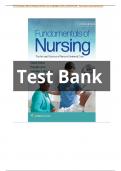TAYLOR,LYNN ,BARTLETT
c
, TEST BANK FOR FUNDAMENTALS OF NURSING 10TH EDITION BY TAYLOR LYNN BARTLETT
c c c c c c c c c c c
TABLE OF CONTENTS c c
Unit I Fondations of Nursing Practice
c c c c c
Chapter 1 Introduction to Nursing and Professional Formation Theory,
c c c c c c
Chapter 2 cResearch, and Evidence-Based Practice Health, Wellness,
c c c c c
Chapter 3 cand Health Disparities
c c
Chapter 4 Health of the Individual, Family, Community, and Environment Culturally
c c c c c c c c
Chapter 5 cRespectful Care c
Chapter 6 Values, Ethics, and Advocacy
c c c
Chapter 7 Legal Dimensions of Nursing Practice
c c c c
Chapter 8 cCommunication
Chapter 9 Teaching and Counseling c c
Chapter 10 c Leadership, Managing, and Delegating c c c
Unit II Health Care Delivery
c c c c
Chapter 11 Health Care Delivery System
c c c
Chapter 12 Interprofessional Collaborative Practice and Care Coordination Across c c c c c c
Settings
c
Unit III Processes of Person-Centered Care
c c c c c
Chapter 13 c Blended Competencies, Clinical Reasoning, and Processes of Person-
c c c c c c c
Centered Care
c c
Chapter 14 Clinical Judgment c
Chapter 15 cAssessing
Chapter 16 cDiagnosing
Chapter 17 Outcome Identification and Planning c c c
Chapter 18 cImplementing
Chapter 19 Evaluating
Chapter 20 Documenting and Reporting c c
Chapter 21 c Informatics and Health Care Technologies c c c c
Unit IV Developmentally Appropriate Care
c c c c
Chapter 22 Developmental Concepts c
Chapter 23 Conception Through Young Adulthood c c c
Chapter 24 c Middle and Older Adulthood
c c c c
Unit V Actions Basic to Nursing Care
c c c c c c
Chapter 25 Asepsis and Infection Control Vital
c c c c
Chapter 26 Signs
c
Chapter 27 Health Assessment c
Chapter 28 Safety, Security, and Emergency Preparedness
c c c c
Chapter 29 Complementary and Alternative Therapies
c c c c
Chapter 30 cMedications
Chapter 31 c Perioperative Nursing c
Unit VI Promoting Healthy Physiologic Responses
c c c c c
Chapter 32 Hygiene
Chapter 33 Skin Integrity and Wound Care
c c c c
Chapter 34 c Activity
c
,Chapter 35 Rest and Sleep
c c
Chapter 36 Comfort
c
Chapter 37 cNutrition
Chapter 38 Urinary Elimination Bowel
c c
Chapter 39 Elimination Oxygenation and
c c c
Chapter 40 Perfusion
c
Chapter 41
c Fluid, Electrolyte, and Acid–Base Balance
c c c c
Unit VII Promoting Healthy Psychosocial Responses
c c c c c
Chapter 42 Self-Concept
Chapter 43 Stress and Adaptation
c c
Chapter 44 cLoss, Grief, and Dying
c c c
Chapter 45 Sensory Functioning
c c
Chapter 46 cSexuality
Chapter 47
c Spirituality
, Chapter01:IntroductiontoNursingandProfessional Formation
c c c c c c c
1. Which of the following statements accurately describe anelement of nursing?
c c c c c c c c c
Select all that apply.
c c c c
A) Theskills involvedin nursingare primarilytechnical innature.
c c c c c c c c
B) Theprimaryfocusofnursing,istoassistindividualstorecoverfromillness.
c c c c c
C) Thescience of nursingis theknowledge basefor the care thatis given.
c c c c c c c c c c c c
D) Theart of nursingis the collection of knowledge throughresearch.
c c c c c c c c c
E) Nursing is considered to be both anart andascience.
c c c c c c c
F) Nursingis aprofession that usedspecialized knowledge andskills.
c c c c c c c c c
2. Which of the following set of terms best describes nursing at the end of
c c c c c c c c c c c c c
ctheMiddle Ages?
c c
A) continuity, caring, criticalthinking c c
B) purpose, direction,leadership c c
C) assessment, interventions,outcomes c c
D) advocacy, research, education c c




